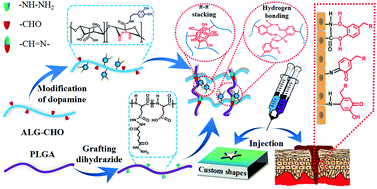Preparation of mussel-inspired injectable hydrogels based on dual-functionalized alginate with improved adhesive, self-healing, and mechanical properties†
Abstract
Injectable hydrogels have aroused much attention for the advantages such as minimally invasive surgery, avoidance of surgical trauma, and filling and repairing irregularly shaped tissue defects. Mussel-inspired injectable hydrogels can be immobilized on the surface of tissues, resulting in stable biomaterial–tissue integration. However, the commonly used biomimetic mussel-inspired hydrogels are prepared by the oxidation of catechol groups, which involves the introduction or production of cytotoxic substances. Moreover, mussel-inspired hydrogels generally display weak mechanical strength and poor adhesiveness because of the consumption of catechol groups during oxidation. Herein, we described a strategy to prepare mussel-inspired injectable hydrogels via the Schiff base reaction. We grafted dopamine, an adhesive motif discovered in the holdfast pads of mussels, to aldehyde-modified alginate backbones. A series of injectable mussel-inspired adhesive, self-healing hydrogels were fabricated by in situ crosslinking of hydrazide-modified poly(L-glutamic acid) (PLGA–ADH) and dual-functionalized alginate (catechol- and aldehyde-modified alginate, ALG–CHO–Catechol). Also, oxidized ALG–CHO–Catechol hydrogels and PLGA/ALG–CHO hydrogels were prepared for comparison. The effects of the crosslinking method, catechol grafting ratio and solid content on the mechanical properties, self-healing behavior, adhesive properties, and hemostatic ability were investigated. Compared with the observations for oxidized ALG–CHO–Catechol hydrogels, more reasonable gelation time and notably enhanced mechanical properties and adhesive behavior were detected in the PLGA/ALG–CHO–Catechol hydrogel system. The PLGA/ALG–CHO–Catechol hydrogels also displayed clear self-healing ability and good cytocompatibility. The strong bioadhesion endowed the PLGA/ALG–CHO–Catechol hydrogels with superior hemostatic performance. These results suggested that PLGA/ALG–CHO–Catechol hydrogel might have great potential as an antibleeding and tissue repair material.



 Please wait while we load your content...
Please wait while we load your content...